|
|
 |
|
One of my research interests is in the effects of longevity on culture. May we hypothesize that sustainable
life grows best during long periods of environmental stability?
|
 |
| Petroglyph in Yosemite National Park, USA |
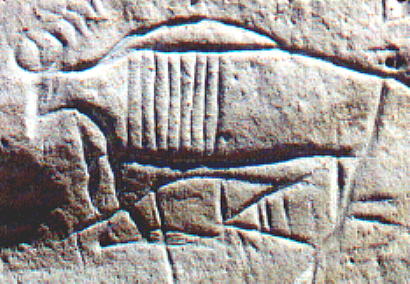
|
| See the interesting band(s) around the bison's middle? |
Above, no one can miss the similarity of the belts around the rhino (and other animals) in Chauvet, France
to the stone image from Yosemite Park in Wyoming, USA. Did these wide belts indicate ownership, as did the belt
at the midsection of the much later Roman slave? May the markings have denoted the "fair game" midsection in which
to strike the mortal blow? Or might they have marked the beast as holy, PREVENTING it from being hunted
or slaughtered?
Not only was culture extremely long-lived in ancient times, but it may also have been widely shared, perhaps
even globally. At the current time, thoughts about what philosophies, energy and technologies might have enabled
the ancient cultures to spread and persist are merely speculations.
| Bear skull found in situ on "altar." |
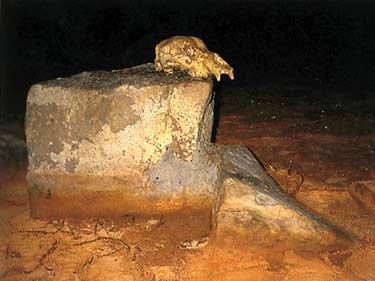
|
| What did this mean deep in the Chauvet cave? |
Isolated for millenia in the pitch-blackness of a cavern only recently found in France, the skull of a large
bear seems curiously perched atop an "alter" of rock that could perhaps represent the bear's body. Extremely high
quality paintings on the walls of the same cavern left by Paleolithic people depict herds of pleistocene creatures, many that
sport black bands around their midsections: plentiful hippos, antelope, mastadon, auroc and horses!
|
 |
| Cave painting of excellent quality discovered in |
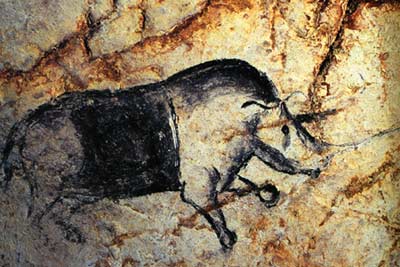
|
| Chauvet, France. |
|
 |
 |
 |
| Monro drew these stone curiosities |
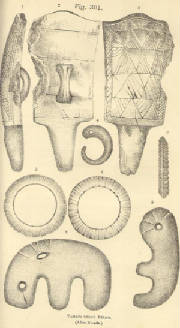
|
| while visiting Japan over 100 years ago. |
Cultures like that of the cave painters lasted without interruption perhaps 20,000 years or more prior to the end of
the last ice age. Could the hunters, as we expect, or megafauna herders perhaps ["like a rhinoceras cowboy"] have been
the outsiders of the dominant societies of their day?
What of the great underwater cities we are now discovering still buried these past 12,000 years under the floodwaters
of the ice age meltdown? What will they tell us about the sustainability of urbanized societies before the LGM?
Just how urban was urban in those times? Could our civilization be one of many that have experienced a rapid technological
boom or maybe a cycle of them interspersed with periods of more sustainable lifestyles?
Connect yourself with our ancient past!
|
|
 |
 |
 |
Below and to the left notice the ubiquity of a known symbol of strength, the bear. A common shape
is the arched four-footed bear; that symbol is shared by recent and apparently ancient Native Americans and also the
ancient Japanese. The small bear amulet to the left was uncovered at a Japanese construction site recently. The
drawing of a magatama in this same form was done a century ago from curiosities collected in Japan.
In North America, a huge (see the meter bar?) stone bear rears up in the woods on a platform bounded by a low rock
wall. We hardly expect to find megalithic structures in the Northeast United States, do we? We
focus on them moreso in Malta and offshore Alexandria and southern Japan and Stonehenge, and perhaps in the Andes. Whatever
was known of megalithic shaping, transportation and construction was lost from the entire living memory of humanity.
What if the huge stone structures we can find in evidence today once formed only the foundations, basements and supports for
much larger and lighter structures that were all washed away with the global superfloods? Questions, questions.
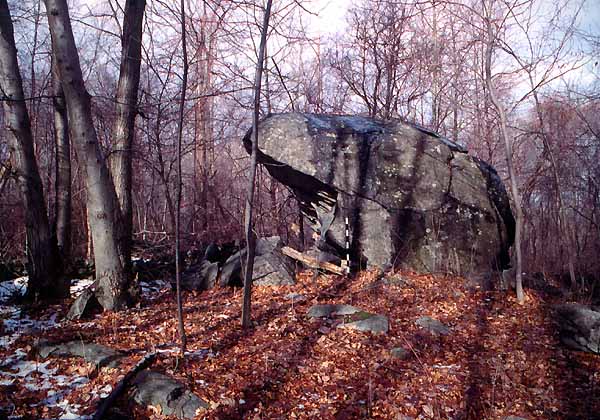
Will WE learn the secrets of cultural longevity in time to avoid the final stormy meltwaters of glacial icecaps that
have remained frozen through at least seven great ice ages and their shorter interglacials over the past 1.5 million years?
They are melting now! They could decisively ruin the habitability of at least our own great coastal communities
all around the Earth, if not severely dent the diversity of life itself.
|
|
|
|
|
|
 |

